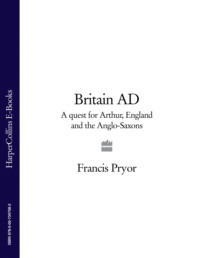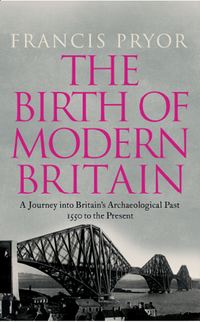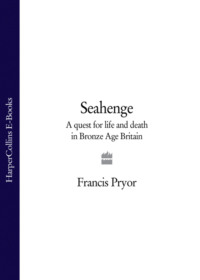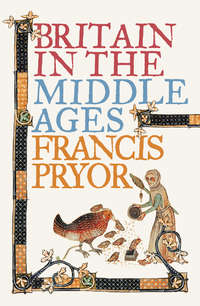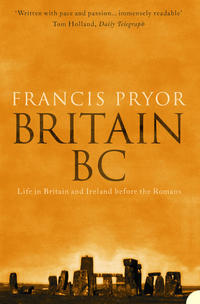
Полная версия
Britain AD: A Quest for Arthur, England and the Anglo-Saxons

BRITAIN A.D.
A Quest for Arthur, England and the Anglo-Saxons
FRANCIS PRYOR


Harper Press
An imprint of HarperCollinsPublishers Ltd. 1 London Bridge Street London SE1 9GF
www.harperpercollins.co.uk
First published by HarperCollinsPublishers 2004
Copyright © Francis Pryor 2004
Francis Pryor asserts the moral right to be identified as the author of this book
Maps and diagrams by Leslie Robinson and Rex Nicholls
A catalogue record for this book is available from the British Library
All rights reserved under International and Pan-American Copyright Conventions. By payment of the required fees, you have been granted the non-exclusive, non-transferable right to access and read the text of this ebook on-screen. No part of this text may be reproduced, transmitted, down-loaded, decompiled, reverse engineered, or stored in or introduced into any information storage and retrieval system, in any form or by any means, whether electronic or mechanical, now known or hereinafter invented, without the express written permission of HarperCollins ebooks
This book is sold subject to the condition that it shall not, by way of trade or otherwise, be lent, re-sold, hired out or otherwise circulated without the publisher’s prior consent in any form of binding or cover other than that in which it is published and without a similar condition including this condition being imposed on the subsequent purchaser
HarperCollinsPublishers has made every reasonable effort to ensure that any picture content and written content in this ebook has been included or removed in accordance with the contractual and technological constraints in operation at the time of publication
Source ISBN: 9780007181872
Ebook Edition © OCTOBER 2009 ISBN: 9780007347582
Version: 2017-01-05
For Maisie
From the reviews of Britain AD:
‘Controversial, deceptively clever and a damn good read’
BBC History Magazine
‘Pryor’s opinionated (yet fairly argued) text rollicks along, informed by a great deal of recent research and new discoveries…Eminently readable’
British Archaeology
‘Francis Pryor has been an eloquent advocate for a new, fascinating vision of the prehistoric past. After Seahenge and Britain BC, this book completes an exhilarating trilogy in which the received ideas of far too long are swept away’
Scotsman
Table of Contents
Cover Page
Title Page
Copyright
Dedication
Epigraph
INTRODUCTION
CHAPTER ONE Origin Myths: Britons, Celts and Anglo-Saxons
CHAPTER TWO The Origins and Legacy of Arthur
CHAPTER THREE Ancient Britons
CHAPTER FOUR My Roman Britain
CHAPTER FIVE Late- and Post-Roman Britain: The Situation in the South and East
CHAPTER SIX The ‘Anglo-Saxon’ Origins of England
CHAPTER SEVEN Arthurian Britain: The Situation in the West and South-West
CHAPTER EIGHT The Making of the English Landscape
CHAPTER NINE Continuity and Change
Conclusion
Keep Reading
Plates
Text illustrations and Maps
Notes
Index
Acknowledgements
About the Author
Other Books By
About the Publisher
INTRODUCTION
Britain ad is in a sense the third volume of an informal trilogy on the archaeology and early history of Britain. It was not planned as a trilogy from the outset, because the idea only came to me gradually, as I was writing the first of the three books, Seahenge. I knew then that I had to write Britain bc, and in my heart of hearts I also wanted very much to tackle the challenge posed by the collapse of Roman rule and the onset of the so-called ‘Dark Ages’ of the fifth to seventh centuries ad. But I felt more than a little daunted by the task. It was the writing of Britain bc that gave me the broader perspective and confidence to undertake the present work.
As I worked on Seahenge, I became aware that I was writing a book about what archaeologists refer to as ‘process’: the methods, approaches and techniques whereby archaeology is actually done. In that sense, Seahenge is a book less specifically about Britain than the other two; but if you read Seahenge first you will derive more from the Britain books, because you will better understand the thought processes behind the work of the various archaeologists and historians involved. Incidentally, I should add here that Mark Brennand and Maisie Taylor have written the full detailed, academic report on that most remarkable of sites.1 Their detailed analysis of the fifty-five timbers—the way they were worked and how they were positioned—has given us a unique insight into the way Early Bronze Age people viewed their world. I do not think it is an exaggeration to say that it has transformed our understanding of Early Bronze Age ritual and religion, and has confirmed many theories that had hitherto been based largely on speculation.
My approach is a personal one. I believe with some passion that archaeology is a personal discipline, and consider it misleading to suggest that there are such things as impersonal, dispassionate or objective archaeological books, just as there are no absolute facts in archaeology, other than the objects themselves. The objects are facts, but anything we attribute to them is interpretation. You may think that a term like ‘cremation urn’ has to be factual; but that presupposes that we all agree on what constitutes a cremation—and here, as elsewhere, there are many grounds for argument. If archaeologists and historians care about their subject, they will have axes to grind, and I prefer to sharpen mine in public.
In all my books I have tried to think and write in time-depth, because I am convinced that the fundamental attitudes underlying human society take a long time to change. Such a long-term view of British history and prehistory would have been impossible without the work of the Venerable Bede, who was one of the ablest minds of all time. It was Bede, in his great Historia Ecclesiastica Gentis Anglorum (Ecclesiastical History of the English People), which he completed in the year 731, who introduced the system of BC/AD to British history.2
In Britain BC I used archaeology to give an impression of what it might have been like to have been alive in the supposedly anonymous and faceless world of prehistoric times. Prehistory, incidentally, is the name given to the study of human history before the advent of writing and written records, which arrived in Britain with the Roman Conquest of AD 43. Too often it is portrayed as a time when individuals, who of course could not be identified, did not matter. So they have tended to be forgotten, their humanity replaced by explanations that assume that prehistoric people somehow lacked free will. In the past prehistorians were too ready to attribute social and cultural innovation to external processes such as migration, economic collapse and environmental change. By approaching their subject in this cold-blooded way, they dehumanised it and made ancient people appear like machines that merely responded to various stimuli in a predictable fashion. This was far too mechanistic for my taste: I prefer my archaeology, like my friends, to be human, fallible and hard to explain. But for some reason nearly all archaeologists detest unsolved mysteries; they would prefer any explanation to no explanation.
Archaeologists dealing with the period covered by Britain ad have also fallen, too often, into a mechanistic explanation of change and the denial of free will to the so-called ‘Anglo-Saxons’. But there is an important difference between the so-called ‘Dark Ages’ and prehistory, because now we are no longer wholly reliant on archaeology. In the present book I have tried to reconcile the contrasting views of ancient life provided by historians and archaeologists; and I conclude that in many significant respects the two are irreconcilable. I do not believe that this matters a great deal, because the authors of the only ‘historical’ sources available were not writing history at all: they were writing polemic, with a well-defined audience and purpose. I shall have more to say on that in Chapters 1 and 2.
In this book I will suggest that in the fifth and sixth centuries AD there are, if anything, rather too many faces: unreliable ancient authors, semi-mythical leaders and one impossible hero called Arthur. These faces have been dominant for far too long, and the voices that have attended them—sometimes their own, more often those of their modern academic supporters—have tended to drown out the quieter, subtler, and to me far more persuasive, stirrings of archaeology. In this book I have made a conscious effort to redress this imbalance.
I have tried to write about more than just the lives of people in the past. I have attempted to make my work relevant to the world around us today. If archaeology is only about antiquity it will soon wither and die, as a pointless, self-serving pursuit. This trilogy addresses themes that matter in the twenty-first century: questions about ideology, the role of religion in daily life, problems of identity and sense of place. In the present book I have also grasped the nettle of what it means to be British—but I do not offer solutions, because there aren’t any. I also avoid the easy way out of saying that there is no such thing as Britishness. Popular definitions of Britishness certainly vary, but that does not invalidate them. Some of them may be jingoistic, or worse, but I believe that a sense of community, however one chooses to define that term, is something worth holding on to in a crowded world that is growing increasingly self-centred.
Finally, I write about something that is surely quintessentially British, namely the keeping up of appearances. Over the years I have become increasingly convinced that the British use their past as a surface coating, a facing, to prevent them from thinking about who they really are as individuals. You can see a rather extreme expression of this tendency if you visit Glastonbury. Anyone who stood outside the Abbey Gates with a loudhailer and proclaimed that Arthur never existed, and that Camelot and Avalon were not intended to be taken as literal truth, would be jeered to the echo, before the rocks began to fly.
Much of the Arthurian New Age ‘philosophy’ is actually quite closely linked to early-twentieth-century views on racial purity, in which people like the Celts were seen to have an actual, ethnic identity. In today’s New Age, the ancient Celt is seen to possess mystical virtues that your average Irish Dark Age warlord would have found less than attractive.Half-baked, wishy-washymysticism would not have appealed to him.
In the first two chapters of this book we will see how Druidism, Arthur and what is called the ‘Celtic Twilight’ are largely modern inventions. This already grossly distorted view of early British history has been further elaborated by the New Agers. I wouldn’t object to this—after all, everyone is free to believe what they choose—were it not for the fact that I detect whiffs of quasi-racism in much of this muddled thinking. I get very wary when I hear talk of how wonderful the Celts were. The unlamented Aryans lurk not far below the Arthurian surface, in legends such as Tristan and Yseult; if, that is, one treats these stories as anything other than fiction, pure and simple.
In Seahenge I played down the full horror of some of the events surrounding the lifting of the timbers from the beach at Holme-nextthe-Sea in Norfolk, as I was writing principally about archaeology, and did not want to chase what I then regarded as a red herring.3 It was also both too close and too unpleasant even to attempt to write about with any degree of objectivity. Readers may however recall that the unfortunate archaeologists on the beach had to face the wrath of neo-Pagans and Druids, which they did with dignity and not a little courage. I remember how one of the Druids proclaimed angrily that he was a ‘British Aboriginal’, and that we were desecrating ‘his’ religious site. I replied, in a foolish attempt to use humour to defuse the situation, that that was fine, because I was descended from Vikings and was therefore allowed to do a little light pillaging. This made him apoplectic with rage. He genuinely believed in his racial purity, and that that gave him certain rights. The linking of rights to race is just a blink away from Nazi beliefs.
Although it is not my main purpose, I do hope to debunk some of these spurious half-truths, and in the process help people come to their own conclusions about what it meant to be British in the past, what it means in the present, and what it will mean in the future—and of these three, the future is the one that matters most.
I have had a lot of fun writing this book. I have visited remote and extraordinary places, and met many old friends and some fascinating new people. The old friends were generally archaeologists, and the new people were mainly historians or specialists in fields of study that a prehistorian such as myself is unlikely to encounter. Britain ad, and the making of the three television films that have accompanied it, has been a wonderful journey of discovery. Having said that, I must sound a note of warning.
Journeys of discovery lead one into uncharted territory, but in the present instance that territory is not the true terra incognita one encounters during academic research. Instead this quest has taken me into realms of the past that have been thoroughly studied by many archaeologists, historians and, more recently, scientists. These scholars might reasonably enquire what business a prehistorian of the Neolithic, Bronze and Iron Ages has with post-Roman Britain. In my defence I can only say that sometimes a fresh view, one rooted in a lifetime’s experience in a different, but closely related, field, can sometimes provide unexpected insights.
I do not think it hurts to view the three or so centuries of the misnamed ‘Dark Ages’ (i.e. from the official end of the Roman Empire in Britain to, say, the mid-seventh century: AD 410—650) as what they were: an insular development out of Later Iron Age culture, following some 350 years of Roman influence.4 In archaeology it is always a good idea to examine origins and consequences: too often we fix our gaze on one period on its own. Chronological isolationism is just as bad as its geographical equivalent; indeed, when it comes to the study of post-Roman Britain it is essential to take a broad view of both time and space.
In this book I have tried to view the events of the post-Roman epoch in greater time-depth than previously. To my mind what happened in Dark Age Britain is not particularly surprising when placed against the backdrop of prehistory. What is strange, however, is the variety of ways in which the post-Roman period has been interpreted by subsequent generations, including our own. I suspect this has something to do with identity: the identity of various élites, including royalty. It also has to do with emerging and beleaguered national identities. Again, I touch on these themes further in the first two chapters.
For myths to arise they often require mystery, and the post-Roman period has always been seen in the popular imagination as particularly mysterious. I was brought up to believe that chaos and anarchy followed the collapse of Roman civilisation in Britain. Out of this primordial cultural soup arose a new form of life which in southern Britain was to be called England. The magic ingredient, the yeast of the brew, was hordes of Continental immigrants who by the early seventh century had transformed post-Roman anarchy into the rugged, no-nonsense world of the Anglo-Saxons. As national origin myths go, that of England is pretty good. It explains why the English are—or think they are—so different from the other nations of Britain. It’s also an excellent story. But whether it’s true or not is another question altogether.
Today most people with even a passing interest in the past are broadly familiar with what one might call the cultural aspects of medieval times. We enjoy their great buildings, their paintings, sculpture and increasingly their music. As a result, we believe we can identify with them. The post-Roman period lurks on the misty, romantic fringes of that world. It’s a period that we wish we could identify with, but sadly we cannot. This is frustrating, because for better or worse the Dark Ages lie at the threshold of the period that gave rise to our own times. As a consequence of this, over the centuries we have recast the Age of Arthur in our own image. This is because historians, story-tellers and others are very good at reshaping the past in ways which reflect contemporary concerns. Today, for example, some of us look to Arthur to supply the mysticism which seems to have vanished from modern life, for whatever reason: perhaps the rationality of science, growing secularism, or even the dogmatic certainties of evangelical religion. These surely are some of the reasons why the Arthur industry is thriving. I have no wish to debunk the hundreds of books, films and videos that appear every year on Arthur and his court. Rather my intention is to think about the contexts of that time and to consider what might actually have happened, given what we know about previous and subsequent epochs from both archaeology and history.
I have already mentioned that the Romans introduced writing to Britain. Of course most people were not aware of it at the time, but this process had already given rise to the discipline of history, which one might define as the study of the past from written sources. These sources can be as diverse as wills, letters, accounts, inscriptions, military commands or ecclesiastical texts, but they are all grist to the historian’s mill. The historian’s tradition is to paint with a broad brush and to seek causes for historical events. Historians also have a tradition of superb writing: open Edward Gibbon’s magisterial The Decline and Fall of the Roman Empire (written between 1776 and 1788) at random, and some resounding passage will tumble forth. This is what Gibbon says about King Arthur. I quote it at length both because it makes excellent sense and because it reads so beautifully:
But every British name is effaced by the illustrious name of ARTHUR,* the hereditary prince of the Silures, in south Wales, and the elective king or general of the nation. According to the most rational account he defeated, in twelve successive battles, the Angles of the North and the Saxons of the West; but the declining age of the hero was embittered by popular ingratitude and domestic misfortunes. The events of his life are less interesting than the singular revolutions of his fame. During a period of five hundred years the tradition of his exploits was preserved, and rudely embellished, by the obscure bards of Wales and Armorica [Brittany], who were odious to the Saxons, and unknown to the rest of mankind. The pride and curiosity of the Norman conquerors prompted them to inquire into the ancient history of Britain; they listened with fond credulity to the tale of Arthur, and eagerly applauded the merit of a prince who had triumphed over the Saxons, their common enemies. His romance, transcribed in the Latin of Jeffrey of Monmouth, and afterwards translated into the fashionable idiom of the times, was enriched with the various, though incoherent, ornaments which were familiar to the experience, the learning, or the fancy of the twelfth century…At length the light of science and reason was rekindled; the talisman was broken; the visionary fabric melted into air; and by a natural, though unjust, reverse of the public opinion, the severity of the present age is inclined to question the existence of Arthur.5
That was going too far, even for Gibbon, who clearly believed in Arthur as a real historical figure.
At first archaeologists followed this grand tradition, but it soon became apparent that the writing of sweeping narrative did not work for archaeology. It’s not that our data do not allow us to draw general conclusions; it’s just that we should not attempt to mimic what historians do so well. As archaeologists we can indeed paint with a broad brush, but we have learnt that it is best to confine our efforts to the painting of archaeological pictures. Today archaeology tends to be more concerned with the long-term processes of social change. We prefer to work with landscapes rather than lineages, and we tend to be less involved with one-off events than with more gradual change. When we do try to pin down specific historical incidents we often become unstuck. The classic case, which I will discuss in Chapter 6, is that of the so-called Anglo-Saxon ‘conquest’ of England, and its aftermath.
Because archaeologists work with data that are foreign to most historians, we are sometimes accused of stretching the evidence too far. I was once kindly, but rather patronisingly, told by a classicist that I, and archaeologists like me, should take lessons on the limitations of inference.6 He did not believe that prehistoric data (i.e. sherds of pottery, fragments of flint, or pieces of bone) were capable of sustaining speculation about the manner in which prehistoric communities might have viewed the world around them. Most prehistorians consider we are ‘speculating’ from the safety of solid statistical or palaeoenvironmental data. We do not believe that we are flying kites. Having said that, we do not believe either that we have actually hit on the truth, because unless a day dawns when we can somehow get inside the minds of long-dead people, we will never know how or what they actually thought. Even then we will have to confront the many prob lems that face anthropologists when they try to explain what motivates tribal societies in various parts of the world today. In fact the long established, innate conservatism of the archaeological profession makes it extremely hazardous for any prehistorian to espouse ‘flaky’ theories, or ideas that tend, however slightly, towards the crackpot. Recently, however, there has been a welcome freeing-up of attitudes. In the past two decades the intellectual climate in archaeology has become more liberal, and slightly less intolerant of dissent from within. Ironically, only history—in perhaps a century or two—will be able to judge the extent to which archaeology is actually revealing truths or is building castles in the air.
There is one important difference between history and archaeology which has nothing to do with the quality of the data we study, but rather its quantity. Written historical information on the post-Roman era in Britain is surprisingly scarce, and new discoveries happen very rarely; when they do, it is often in the course of archaeological excavation. By contrast with the essentially static historical ‘database’, that of archaeology is constantly increasing. Hardly a day goes by without some new discovery. Often these discoveries might appear routine and unimportant, such as the exposure of the footings of yet another Saxon-period house, but these isolated pieces of information can be fitted together to form a coherent pattern. It’s a process that can take years, as we will see (Chapter 8) in the case of Dominic Powlesland’s work at West Heslerton in Yorkshire, but that does not make it any less reliable. The progress of archaeological research tends to be gradual and cumulative; it can only be measured from time to time. That is why it is sometimes necessary to step back in both time and space to take a broader view.




